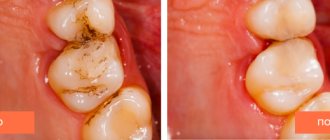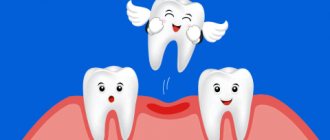Hyperesthesia is the increased sensitivity of tooth enamel to chemical, mechanical and temperature influences. An unpleasant reaction can occur to acidic foods - fruits, berries, as well as hot and cold foods and drinks. Pain may occur during chewing and touching the enamel with a toothbrush.
In ICD-10, this condition is assigned code K 03.8. It is important to understand that often dental hyperesthesia is not an independent disease, but occurs as a result of the development of certain pathologies.
Hyperesthesia - what is it?
Name " hyperesthesia"
" comes from two Greek words meaning "increase" and "feeling". The pathology got its name from a characteristic feature - painful sensitivity of teeth to temperature, chemical, tactile (physical) influences. Hyperesthesia should not be confused with pain that occurs with carious tooth decay. Hyperesthesia often occurs with non-carious lesions of hard dental tissues and chronic periodontitis.
Manifestations of hypersensitivity in different dental pathologies are not the same. Thus, enamel erosion causes quite severe, albeit short-term pain, and with a wedge-shaped defect, the discomfort is mild, however, sometimes unpleasant sensations appear even with the slightest exposure of the neck of the tooth.
Theories of dental hyperesthesia
In dentistry, there are several theories of the occurrence of pain during hyperesthesia:
- Receptor - discomfort may appear as a response to irritation of the nerve in the dentin tubes.
- Nervous-reflex pain is the result of a disruption in the process of ion exchange in tissues and an increase in the perception of stimuli by the dentin receptor apparatus.
- Hydrodynamic - according to this theory, pain occurs as a result of fluid circulation in the dentin canals. It is this theory that has become most widespread.
The code for dental hyperesthesia according to ICD 10 is K03.80. In Russia, the International Classification of Diseases, 10th revision (ICD-10) has been adopted as a single regulatory document for recording morbidity. A special code assigned to dental sensitivity allows dentists to accurately diagnose and correctly select ways to treat the disease. Dental hyperesthesia ICD 10 requires the intervention of a professional dentist.
Causes of hyperesthesia
A generally accepted classification of pathology has been developed, based on which the dentist makes a conclusion about the causes of increased tooth sensitivity. The classification systematizes predisposing factors. By comparing them with a specific case and making instrumental diagnostics, the doctor makes a conclusion about the origin of the pathology and classifies it as one of the varieties.
By localization:
- limited
- it affects one or more teeth. Usually these are ground teeth, teeth with a wedge-shaped defect; - generalized
- affects most of the dentition, sometimes the entire row. Progressive erosion of the enamel, exposure of the neck of the tooth during periodontitis, and increased tooth abrasion lead to generalized erosion.
By origin:
- caused by loss of hard dental tissues
. Its appearance is provoked by carious cavities, enamel erosion, increased abrasion, orthopedic preparation (grinding) for prosthetics; - not associated with the loss of hard dental tissues
. It occurs if the neck or root of the tooth is exposed, which can be caused by periodontal diseases, general diseases - endocrine pathologies, neuroses, gastrointestinal pathologies and others. Visually, in such cases, the enamel appears intact.
Medical errors can also be the cause. Hypersensitivity occurs if, during the finishing treatment of the filling, healthy tissue was sanded, the filling technique was violated, the enamel was over-etched, or ultrasonic teeth cleaning or whitening was performed incorrectly.
A lot of calls to clinics occur precisely because of incorrect bleaching. Hyperesthesia can occur after the procedure when it is performed without taking into account contraindications and the characteristics of the patient’s teeth.
The high incidence in women is due to hormonal and metabolic disorders, especially a decrease in estradiol. They show decreased levels of magnesium and calcium, and bone tissue shows lower density. Therefore, women undergoing dental treatment should undergo additional studies as prescribed by a dentist-therapist.
Material and methods
The study was conducted at the Department of Therapeutic Dentistry of the Belarusian Medical Academy of Postgraduate Education. Its subjects were 98 patients aged from 20 to 75 years. The assessment of the initial dental status began with a survey, clarification of complaints and collection of anamnesis. During the survey, we found out which irritants (cold, hot, acidic, mechanical, chemical) cause sensitivity of hard dental tissues, the severity of which was determined according to the following codes and criteria: no pain - 0 points, slight pain - 1 point, severe and very strong - 2 and 3 points, respectively. The index assessment involves determining the level of oral hygiene using the simplified Green-Vermillion OHI-S index (Green, Vermillion, 1964). The intensity of periodontal diseases was determined using the complex periodontal index KPI (P.A. Leus, 1988), the intensity of dental caries damage was determined using the KPI index (Klein, Palmer, 1937). The affected area was examined in detail, namely the presence of dental caries, gum recession, wedge-shaped defects, erosions, microcracks and chips of enamel, as well as abrasion of tooth crowns. We used basic and additional examination methods. Dental hyperesthesia was assessed using the dental hyperesthesia prevalence index (DHI), dental hyperesthesia intensity index (DHI); G.B. Shtorin (1986), tactile sensitivity of hard tissues of teeth - using a dental probe. The tip of the instrument was placed perpendicular to the vestibular surface of the tooth being examined and zigzag movements were made along the enamel-cement junction for several seconds. If this irritation caused a pain reaction in the patient, the presence of hyperesthesia was recorded. To assess temperature sensitivity, teeth were irrigated from a syringe with water at a temperature of 30 °C. The use of water at this temperature is explained by the fact that in case of functional enamel deficiency, tooth pain occurs under the influence of a cold stimulus whose temperature is less than 37 °C [1]. To study the reaction of the tooth to the air flow, a stream of air from a dental plaster was used for 2-3 s, directed from a distance of approximately 1 cm at an angle to the tooth surface being studied.
After the examination, making a preliminary diagnosis and developing a general treatment plan, information about the examination results, preliminary diagnosis and prognosis of the disease was provided in full to the patient and agreed with him. A necessary precondition for medical intervention was the voluntary informed consent of the patient.
Clinical picture of hyperesthesia and degree of hypersensitivity
Hyperesthesia can manifest itself in different ways. A typical sensation is intense, albeit short-term pain (about 30 seconds), a “shooting” in the jaw due to hot or cold (more often), very salty, sweet, sour foods and drinks. Sometimes severe pain occurs when inhaling cold air.
With hyperesthesia, this reaction occurs constantly, the relief is short-term and insignificant. The patient often cannot identify the tooth that is causing pain. An external examination does not reveal any difference between the teeth in the row, there is no pathological pigmentation, the enamel appears hard and smooth.
Degrees of the pathological process:
- Discomfort is caused by heat or cold exposure, the threshold values of dentin excitability are 5-8 μA.
- Discomfort is caused by heat, cold, salty, sour, sweet; the threshold values of dentin excitability are 3-5 μA.
- Pain is provoked by all irritants, including simple touch; the threshold values of dentin excitability are 1.5-3 µA.
Hypersensitivity significantly complicates oral care; even ordinary cleaning becomes a challenge, and if the process is developed and neglected, it becomes impossible. The enamel and interdental spaces gradually accumulate deposits, which can lead to caries, gingivitis, and periodontitis.
In order not to provoke the development of serious complications, the consequences of hyperesthesia, you need to contact a specialist already at the first stage of the process, with mild sensitivity.
Oral care for hyperesthesia
Hygienic care in the presence of increased tooth sensitivity is especially difficult in the third stage of the disease, because in this case the patient has a reaction to tactile influence. Experts advise choosing toothbrushes with soft, rounded bristles and toothpaste labeled “for sensitive teeth.” In this case, the brush should be regularly replaced with a new one to prevent infection. Toothpaste also needs to be replaced periodically, this will increase the effect of protecting teeth. It is useful to use mouth rinses, especially after meals.
Diagnostics
Hyperesthesia is differentiated from other conditions that have similar symptoms:
- with inflammation of the pulp;
- with caries;
- with a cracked tooth or restoration;
- with a violation of the sealing layer.
A characteristic symptom of hypersensitivity is quickly subsiding, acute pain. To determine it, the doctor checks the condition of the nerve bundle using x-rays or electrodontometry. If the preliminary diagnosis is hypersensitivity, the dentist conducts tests to determine the degree of reaction of dental tissues to temperature, chemical, and tactile stimuli. When the degree is determined, the doctor draws up an individual treatment and prevention plan.
Therapy for hyperesthesia
Hyperesthesia is treated comprehensively, in collaboration between the doctor and the patient, because it involves clinical manipulations, specific procedures and self-care.
First of all, the cause of hypersensitivity is eliminated - periodontitis, periodontal disease are treated, low-quality orthopedic structures and fillings are replaced, and cervical defects are eliminated. If there are indications, microplastic correction of the gums is performed, during which it is raised to a normal level and the exposed roots are covered.
Conservative therapy should normalize hydrodynamics in dentin microchannels. Remineralization will reduce the volume of microspaces and normalize phosphorus-calcium metabolism. The patient needs to undergo a course of treatment, during which every day 10 percent calcium gluconate is applied to the surface of the teeth and the enamel is coated with a fluoride-containing preparation.
In order for the life-saving ions to better penetrate the dental tissues, electrophoresis is used. Physiotherapy makes it possible to introduce certain ions and control their concentration. Electrophoresis is absolutely safe if it is carried out by a competent specialist, and the drugs injected into the tissue are non-toxic. Physiotherapy lasts about 2 weeks, but already at the beginning there is an improvement in well-being, and by the end of the course of treatment a stable remission occurs.
The duration of remission will depend on many factors - the characteristics of a person’s hard dental tissues and the quality of self-care for teeth. If conservative therapy with saline applications does not produce a pronounced effect, the enamel is covered with filling material, but this usually occurs in advanced or clinically complex cases.
Drugs used in the treatment of hyperesthesia
All drugs for the treatment of dental hypersensitivity can be divided into 2 groups:
- Drugs that seal the dentinal canals reduce the flow rate of the cerebrospinal fluid. This group is represented by varnishes, oxalates, desensitizers, remineralizing liquids and gels. The drugs are used to carry out remineralizing therapy and fluoride teeth.
- Drugs that block nerve fiber signals that stop the transmission of pain impulses. The group is represented by local products based on potassium nitrate. They are applied in the form of gels and applications.
The named drugs (according to individual indications) are also used immediately after brushing and whitening teeth. A long-acting desensitizing gel is applied to the tooth surface. If severe pain develops, the specialist prescribes universal mouth guards with gel. The condition improves significantly after the 1st procedure.
- 1. Fluoride therapy.
The action of these drugs is determined by the reaction of fluoride ions and calcium ions. When they combine, they form calcium fluoride, an insoluble salt that clogs the dentinal canal. Different brands of fluorides work differently. To obtain a lasting, pronounced effect, the doctor must use a modern, effective drug.
- 2. Therapy with fluoridated varnishes.
Fluorinated varnishes reduce hypersensitivity for a short time. After a few hours or days, the varnish will be erased from the surface of the tooth. To make the effect of the varnish more pronounced and lasting, the varnish is applied in multi-layers. The advantage of this technique is the blockage of micropores and instant relief of the condition.
- 3. Therapy with remineralizing pastes.
Remineralizing pastes help restore the mineral balance of hard dental tissues. There are several varieties of these drugs - for use in the dentist's office and at home. Which of them and for how long to use is determined by the doctor.
- 4. Desensitizer therapy.
The name of the group of drugs comes from the English word desensitizer, which means “reducing sensitivity.” Desensitizers contain substances whose task is to seal dentinal canals by coagulating proteins. The preparations are used to restore the surface of teeth, for restoration or universally.
- 5. Oxalate therapy.
Oxalate preparations, like fluorides, are used to form insoluble salts in dentin. When using oxalates, there is no need to etch the enamel or use a photopolymerization lamp; oxalates do not irritate the gums. As a result of oxalate therapy, salt crystals tightly clog the dentinal canals, which effectively reduces hypersensitivity.
Prognosis for hyperesthesia and preventive measures
If treatment is started early, the prognosis is favorable. A complex of clinical procedures plus compliance with medical recommendations leads to the onset of stable remission without pain, discomfort, or the risk of complications.
To prevent the development - initial or repeated - of hyperesthesia, it is recommended:
- bring your diet back to normal, limit your intake of foods that destroy enamel. To do this, it is necessary to exclude or limit carbonated drinks and excessively sour dishes in the diet, and use a straw when drinking juices;
- enrich your diet with foods containing calcium and phosphorus - they will help the body maintain optimal mineral balance and bone strength;
- After each meal, it is always recommended to rinse your mouth with a special mouthwash or regular warm water;
- undergo preventive examinations of the oral cavity every six months so as not to trigger the development of carious and non-carious diseases. The latter are especially dangerous, since outwardly they are invisible, and the dentist will identify them in time and provide assistance;
- monitor the condition of the stomach and the entire gastrointestinal tract, since their system directly affects the condition of the teeth.
Prevention measures
- Eliminating bad habits (biting hard objects, cracking nuts)
- Using special toothpaste and a soft brush
- Using proper brushing technique (“up and down”)
- Thorough oral hygiene at least twice a day
- Rinsing your mouth after eating
- Reducing the diet of natural juices and carbonated sweet drinks
- Regular preventive visits to the dentist
The network of dental clinics “Smile” offers services for the diagnosis and treatment of dental hyperesthesia. Contacting our specialists has a number of undeniable advantages:
- reception of highly qualified doctors;
- compliance with treatment protocols that meet international standards;
- providing family and cumulative discounts;
- transparent pricing;
- Convenient work schedule: daily until 21:00 (Sunday until 16:00).
You can make an appointment at any of the branches of our clinic in Moscow, located within walking distance from metro stations:
- Alekseevskaya (VDNKh district, etc. Mira), address: st. 3rd Mytishchiskaya house 3, building 2;
- Shelepikha, address: Shelepikhinskaya embankment, building 34, building 1.
The high qualifications of our specialists and modern equipment allow us to solve the problem of dental hyperesthesia at any stage of the disease. We guarantee the effectiveness of treatment and the safety of the methods used. Your health is in good hands!











